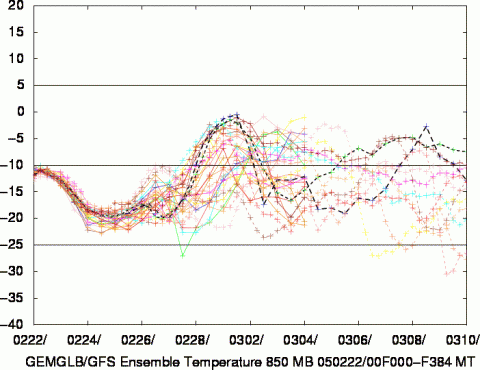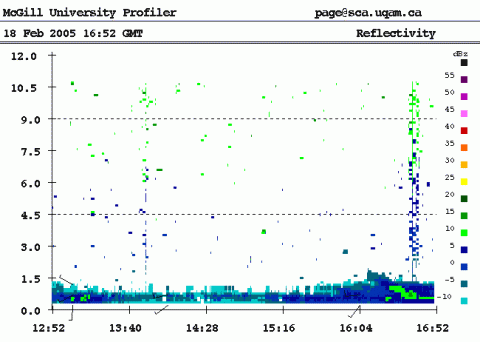-
Compteur de contenus
2 418 -
Inscription
-
Dernière visite
Type de contenu
Profils
Forums
Events
Gallery
Tout ce qui a été posté par beachcp31
-
A surveiller, même si l'échéance est encore lointaine. Mais pour le moment cela demeure très hypothétique. Cependant, seul le ECMWF 12 UTC et le GFS 00 UTC du 22 février donnent une dépression importante près de nous. Le GFS 18 UTC ne développe plus cette dépression. GEM-GLB 00 UTC du 22 février et UKMET 12 UTC ne la développe pas et elle demeure alors bien au sud. La dispersion des prévisions d'ensemble est encore bien grande à cette échéance.
-
Oui, c'est tout à fait possible. Il n'est pas modéré cependant, alors n'importe qui peut y venir. S'il y a des problèmes je peux mettre usager et mot de passe. Je n'avais pas mis de lien car je n'avais pas eu de demande en ce sens jusqu'ici. Il est donc utilisable par tous les intéressés.
-

Image radar : la dépression semble faiblir
beachcp31 a répondu à un(e) topic de Mistral21 dans Discussions générales
Finalement la zone de neige tarde à se déplacer à l'est de la région de Montréal! Intéressant comme situation... -
Bon matin à tous! C'est avec grand plaisir que je dévoile les cartes horaires régionales pour la France, qui sont en ligne depuis vendredi! Avec tout le temps de gestion du forum, je n'avais pas pu prendre le temps de vous en faire part. Pour le moment, la France est divisée en quatre, les isobares sont à intervalle de 1 hPa et les géopotentiels aux 2 dam. Les cartes sont accessibles lorsque vous visualisez l'analyse sur la France. Peut-être une carte supplémentaire pour IDF? J'attends votre avis! Ah! Cela fait du bien d'écrire un message comme cela!! Ici à Montréal, chute de neige de 10cm prévue demain avec vents modérés et temps froid... Tn=-18C (refroidissement éolien -30) et Tx=-10C demain. Ensuite, temps froid sous la normale, Tn=-16C et Tx=-8C.
-

Forte averse de neige - Montréal centre ville.
beachcp31 a répondu à un(e) topic de Regg001 dans Discussions générales
-
Fin de la discussion hors sujet Les messages ont été "épurés" en tentant de ne laisser que les informations pertinentes. Les discussions personnelles en privé svp!
-
Problème de transmission des données ou station défectueuse...!
-
La station près de Thetford Mines est Beauceville, pointée sur les cartes d'aujourd'hui. Code de station : WHV 71323 BEAUCEVILLE QB CN 4620 -7078 229
-
Tout est dans ce fichier: http://ftp.cmc.ec.gc.ca/metstat/metstat1.txt Cela confirme ce que j'ai mentionné ci-haut: LEMIEUX |QUE |Q|WVY|71616| 46 18 72 04|0097|AU8 On a aussi: VILLEROY RADAR |QUE |Q|WVY| | 46 27 71 55| |WSR| | | | |
-
Voici les coordonnées: CWVY | 46.30 | -72.05 | 97|Lemieux, QB C'est près de Villeroy, dans Lotbinière je crois... Je vais la rajouter dans la liste des stations pour les observations du sud du Québec.
-
Je crois bien qu'EC aura raison en analysant les observations actuelles...
-
Les prévisions n'ont pas été mise à jour à 11h30 comme à l'habitude pour l'ouest du Québec à court terme... Et les runs de 00UTC du GEM ne laissaient entrevoir que 1-4cm dans la grande région de Montréal, mais avec une forte incertitude vu le très fort gradient d'accumulation et l'incertitude de la trajectoire. Cela se jouera au 100km près (environ 6 points de grille du modèle GEM-REG seulement) avec un gradient très fort d'accumulations. Pour la neige, oui il y a eu un peu de neige faible ce matin au centre-ville, mais des flocons très petits et brièvement une réduction de la visibilité, mais pas grand chose. C'était plutôt fondant vu le sol chaud.
-
La trajectoire, selon les modèles GEM-REG et GEM-GLB, s'est déplacée vers l'ouest: au lieu de passer à l'est de Cape Cod, le centre dépressionnaire est prévu passer près de Boston. Il semble que le creux en altitude se referme plus lentement et se déplace plus lentement, ce qui permet à la dépression de passer un peu plus à l'ouest. Ce sont les modèles canadiens qui prévoient le plus de neige pour la région de Montréal (près de 20cm) tandis que le NAM et le GFS sont plus timides, entre 4-10 cm. La discussion du CMC dit: ERN RGNS.. MAIN DIFFERENCE IN THE EAST IS WITH A STGR UPR RDG OVR THE MRTMS MAINLY AT T+36H. AS A RESULT DEEPER, SLOWER LOW IS ESPECTED TO MOVE OFF US SEABORD MORE IN LINE WITH FOREIGN MDLS AND THAT IS ACCEPTED. HOWEVER NEW INTEGRATION PUSHED MORE QPF OVR SRN QC AT T+36H. NEW NAM IS FARTHER S WITH LESS QPF OVR SRN QC. ATM FIND THAT GEM REG MIGHT BE PUSHING QPF TOO FAR NORTH AS RECENT VERIF WOULD SUGGEST. WILL REASSESS THIS AFTERNOON AS NEW GUIDANCES BECOME AVLB. Donc le changement semble relié à la crête an altitude sur les maritimes qui est plus forte que prévue, ce qui ralenti la progression de la dépression vers l'est. Cependant les quantités de précipitations prévues par les GEM doivent être évaluées mais semblent trop fortes selon l'analyste.
-
Ces stations supplémentaires sont des stations automatiques. Dépendant du type de station automatique, tous les types de mesures ne sont pas disponibles. Certaines stations ne mesurent que les vents par exemple.
-
En effet, le serveur du NWS NOAAPORT qui nous envoit les données du GTS avait des problèmes depuis hier soir, donc retard ou manque dans les données...
-
Et aussi le nombre d'usagers simultanés dans le forum: Le nombre maximum d'utilisateurs en ligne simultanément a été de 28 le Dimanche 23 Janvier 2005 14:49
-
Je voudrais pour ma part remercier Laurent pour toutes ses contributions aux discussions intéressantes ici sur le forum, et sa participation à cette petite communauté. 212 messages, ce n'est pas rien: Top 10. Je respecte également ta décision, personne n'est obligé d'écrire dans le forum, libre à toi. Je rajouterai que depuis les débuts du forum, c'est la première fois qu'il y a vraiment des problèmes. J'espère que cela demeurera un incident isolé. Alors, à bientôt, et je te souhaite bon succès dans tes projets.
-
J'ai remplacé le logiciel de chat par la version finale 3.0 au lieu de la version beta. J'espère qu'il fonctionnera mieux. Cependant, vous devrez enregistrer vos pseudos à nouveau, désolé...
-
J'ai implanté plus vite que prévu une analyse régionale France pour le sud-ouest: http://meteocentre.com/analyse/map.php?hou...fr&map=SWFrance Bientôt les autres régions, dans les prochaines semaines! Profitez-en!
-

Problème model GFS sur MétéoCentre
beachcp31 a répondu à un(e) topic de MétéoQuébec dans Discussions générales
Merci, je viens de corriger le bug. En fait, je regarde les images sous forme de panneaux, alors c'est pourquoi je ne m'en étais pas aperçu... J'ai mis à jour la run de 18Z, les autres le seront graduellement demain. -

Point Neige et Froid Sud-Ouest
beachcp31 a répondu à un(e) topic de Piloutop dans Discussion générales
Je vois 8.6 à Montauban à 20 UTC: http://meteocentre.com/cgi-bin/get_syng?stn=75400&tim=20 Changer le tim=20 par tim=21 pour 21 UTC quand les données seront disponibles. Paramètre TMPC (voir liste des paramètres ici: http://my.unidata.ucar.edu/content/softwar...hap3.php?sfparm) STN YYMMDD/HHMM PMSL PRES P03D TMPC DWPC SPED DRCT GUMS VSBK P03M P06M P09M P12M P18M P24M TDXC TDNC T12X T12N WWMO PWWM CFRT CFRL CTYL CTYM CTYH CLHL CLHM CLHH SSTC WPER WHGT MSUN SNOW CBAS SNEW P24C PWSP PWDR LFDB 050123/2000 1016.20 1003.10 3012.00 8.60 7.50 4.10 310.00 7.20 -9999.00 -9999.00 -9999.00 -9999.00 -9999.00 -9999.00 -9999.00 -9999.00 -9999.00 -9999.00 -9999.00 -9999.00 -9999.00 -9999.00 -9999.00 -9999.00 -9999.00 -9999.00 -9999.00 -9999.00 -9999.00 -9999.00 -9999.00 -9999.00 -9999.00 -9999.00 -1.00 -9999.00 -9999.00 -9999.00 -9999.00 -

Point Neige et Froid Sud-Ouest
beachcp31 a répondu à un(e) topic de Piloutop dans Discussion générales
N'oubliez pas que vous pouvez aussi poster vos observations complète de la région Toulousaine ici même: http://meteocentre.com/toulouse/obs/ et sur MétéoAlerte France bien sûr si cela le requiert. Le lien est sous Obs Toulouse dans le haut de la page. Bonne chance pour la neige!! Ici à Montréal un énorme tempête nous effleure et nous ne subiront "que" 2 cm et du froid intense... -
Probablement causé par une surcharge du serveur ftp de la NOAA. Tout semble normal ce soir.
-

où sont passé les tempêtes de neiges d'autrefois?
beachcp31 a répondu à un(e) topic de vortex dans Discussions générales
J'avais déjà répondu à ce type de question l'automne passée. Voir le message ici: http://meteocentre.com/forums/index.php?ac...findpost&p=7391 -
Arghh!! J'ai corrigé le bug... et regénéré tous les RS de 00 et 12 UTC de même que les composites. Ici je congèle avec T=-24C, Td=-32C, vents 24km/h, refroidissement éolien -36... Tx prévu de -19C...



